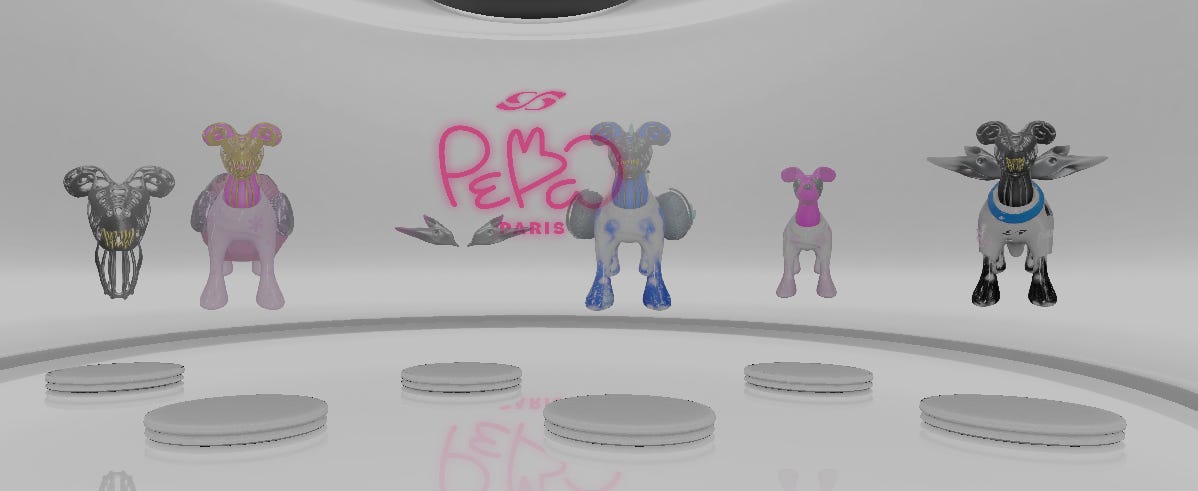The most interesting thing about fashion in the metaverse is the lack of constraints. While there are still technological challenges in taking what a designer can see in their mind’s eye and turning it into a digital file, I assume those will decrease rapidly with time. But the normal design constraints, say, gravity, the nuances of the human body, the costs of fabric, weather, etc., are gone! Poof! It’s been said that constraints fuel creativity, that you need some limits to work within to drive innovation. What happens when those limits disappear. This takes away fashion’s utility and makes it purely art. I am not sure if that’s a good thing or a bad thing, but it’s certainly a “thing.”
Like Maye Musk in this DressX promo. Can’t wear that in the real world.
From an interesting NYMag article with Katie Haun of Andreessen Horowitz
Haun talks a bit about digital scarcity and NFTs and how that’s going to play out in the real world. It’s a little bit the opposite of the fashion argument, where you’re introducing manufactured scarcity, but NFT’ing things that are actually scarce, like web domains. Or to keep to our theme, phygital goods, like Birkins, that are also linked to an NFT.
From the article:
“Let’s talk about real-world examples. Right now, I can go buy a movie on a platform, whether on Prime Video, or streaming. How many times have people said, “Did I own that book? Did I own that movie? Did I buy it on another platform? Where is it?” If you actually bought something in the physical world in the days of the VHS cassette tape, you owned it. But to date, in the digital world, that’s not been the case. You buy a song, you don’t own it. You buy an Amazon Kindle book, you don’t own it. If you’re done with it, and you want to give it to someone, you can’t. You’re restricted. You cannot sell it or pledge it as collateral. When you buy a good in the physical world, whether it’s a book, movie, purse, piece of clothing, piece of art, or whatever, you can do what you want with it. Increasingly, people are buying digital goods and spending a lot of money on digital goods, but they don’t actually own them. Why don’t they own them? Because they’re not digitally scarce. They rely on a central gatekeeper. The platform owns it and they set the rules of the road for what you can do with it in quite a different way than when you buy a good in the physical world.
…there are things they (the average consumer) can’t buy digitally that they might want, like maybe a Twitter handle. Maybe they would want to buy someone else’s Instagram handle. There’s no marketplace for that right now. What if you actually own something, whether it’s a domain name or a handle digitally. If they were digitally scarce, there could be marketplaces for those. I think that’s really interesting. You can buy domain names, for example, right now on OpenSea.”
NFTs for Pets!
Thank you The Dematerialised, this is what I’ve been waiting for!
Tribute Brand, … is looking beyond humans in their latest fashion drip with DMAT. Expanding into petwear, their newest launch marks a new era for animals in the metaverse, and we can’t wait to share this collection with you. PEPA PARIS.
Talk about being disconnected from the demands of the physical world. There's no good reason not to dress your dog in digital fashion. It’s an extension of your brand. I love it. I can’t wait to dress my kids in the metaverse, since in real life I have absolutely no control of their toddler fashion tastes.
The Met Gala of England….
The British Fashion Council held their Fashion Awards, which now includes a metaverse award, going to cSapphire. There was also a virtual red carpet version of the Royal Albert Hall on Roblox.
Three things I thought about re: this red carpet splash. One is cSapphire’s store on Roblox. Never have I felt so old clicking on a link. Two is the red carpet social media blitz of commemorative digital fashion from the Dematerialised and Lukso, which I will say looked fantastic on Imran Amed of the Business of Fashion’s tux. Three, why was the award only for Roblox creators? I’m sure the obvious answer is money changing hands somewhere. And there’s also an interesting question of limiting creativity; Roblox designs must exist within the confines of the game’s avatars. (see cSapphire’s store above).
Other news
A couple held their wedding in the metaverse. Talk about separating from the demands of the physical world and turning wedding planners into fantasy-land creators beyond our wildest dreams. Colin Cowie watch out! And every bride can have the princess concoction of her dreams. I’m not sure Town and Country will be covering these soirees just yet, but it can’t be too far off.
Finally, a story with an Instagram filter
I’ve written about the fact that all the press releases I read about virtual fashion collaborations always happen on Snapchat. There are business and technical reasons for this, but it seems kind of nuts that Instagram wouldn’t be more committed to bringing virtual fashion to Instagram. Well, thank god Timberland has made it happen. Is Timberland cool?
Interesting that this is still news in the ad world
Of course, Ralph Lauren is doing brand activations in Roblox. I think we should be talking about who isn’t. Chanel, for one, which is par for the course. And if you’re Chanel, you do what you want, but I’d love to know more about the other big brands sitting out on the metaverse and what their POV is.




